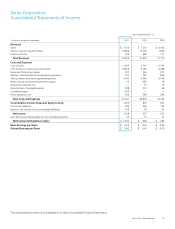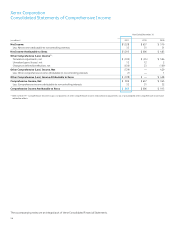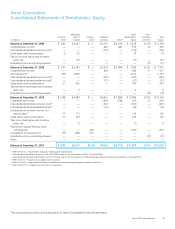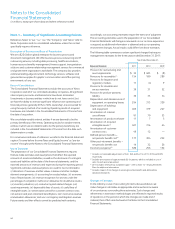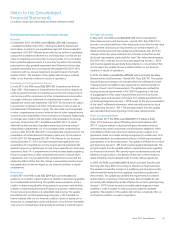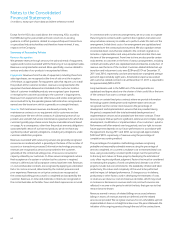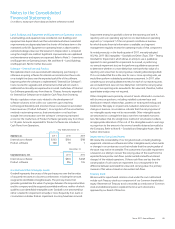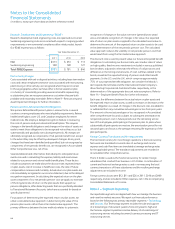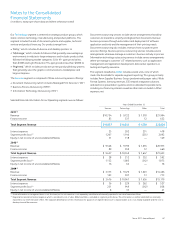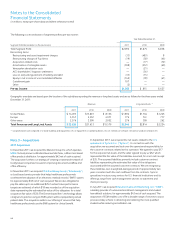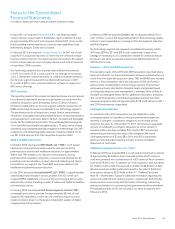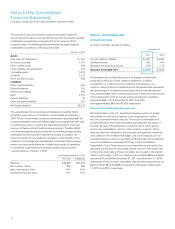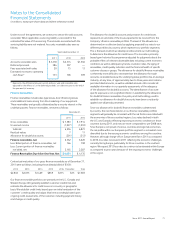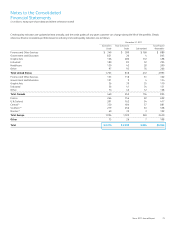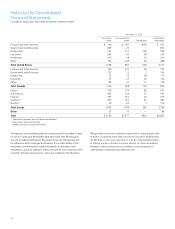Xerox 2011 Annual Report Download - page 66
Download and view the complete annual report
Please find page 66 of the 2011 Xerox annual report below. You can navigate through the pages in the report by either clicking on the pages listed below, or by using the keyword search tool below to find specific information within the annual report.
64
The objective of using an estimated selling price-based methodology is
to determine the price at which we would transact a sale if the product or
service were sold on a stand-alone basis. Accordingly, we determine our
best estimate of selling price considering multiple factors including, but
not limited to, geographies, market conditions, competitive landscape,
internal costs, gross margin objectives and pricing practices. Estimated
selling price-based methodology generally will apply to an insignificant
proportion of our arrangements with multiple deliverables.
CashandCashEquivalents
Cash and cash equivalents consist of cash on hand, including money-
market funds, and investments with original maturities of three months
or less.
RestrictedCashandInvestments
As more fully discussed in Note 16 – Contingencies and Litigation, various
litigation matters in Brazil require us to make cash deposits to escrow as a
condition of continuing the litigation. In addition, as more fully discussed
in Note 4 – Receivables, Net, we continue to service the receivables sold
under most of our accounts receivable sale agreements. As servicer, we
may collect cash related to sold receivables prior to month-end that will
be remitted to the purchaser the following month. Since we are acting
on behalf of the purchaser in our capacity as servicer, such cash collected
is reported as restricted cash. These cash amounts are classified in our
Consolidated Balance Sheets based on when the cash will be contractually
or judicially released (refer to Note 10 – Supplementary Financial
Information for classification of amounts).
Restricted cash amounts were as follows:
December 31,
2011 2010
Tax and labor litigation deposits in Brazil $ 240 $ 276
Escrow and cash collections related to
receivable sales 88 88
Other restricted cash 15 7
Total Restricted Cash and Investments $ 343 $ 371
Inventories
Inventories are carried at the lower of average cost or market. Inventories
also include equipment that is returned at the end of the lease term.
Returned equipment is recorded at the lower of remaining net book value
or salvage value. Salvage value consists of the estimated market value
(generally determined based on replacement cost) of the salvageable
component parts, which are expected to be used in the remanufacturing
process. We regularly review inventory quantities and record a provision
for excess and/or obsolete inventory based primarily on our estimated
forecast of product demand, production requirements and servicing
commitments. Several factors may influence the realizability of our
inventories, including our decision to exit a product line, technological
changes and new product development. The provision for excess and/or
obsolete raw materials and equipment inventories is based primarily on
near-term forecasts of product demand and include consideration of new
product introductions, as well as changes in remanufacturing strategies.
The provision for excess and/or obsolete service parts inventory is based
primarily on projected servicing requirements over the life of the related
equipment populations.
MultipleElementArrangements: We enter into the following revenue
arrangements that may consist of multiple deliverables:
•Bundled lease arrangements, which typically include both lease
deliverables and non-lease deliverables as described above.
•Outright sales of equipment with a related full-service maintenance
agreement.
•Contracts for multiple types of outsourcing services, as well as
professional and value-added services. For instance, we may contract
for an implementation or development project and also provide
services to operate the system over a period of time; or we may
contract to scan, manage and store customer documents.
If a deliverable in a multiple-element arrangement is subject to specific
guidance, such as leased equipment in our bundled lease arrangements
(which is subject to specific leasing guidance) or accessory software (which
is subject to software revenue recognition guidance), that deliverable is
separated from the arrangement based on its relative selling price (the
relative selling price method – see below) and accounted for in accordance
with such specific guidance. The remaining deliverables in a multiple-
element arrangement are accounted for based on the following guidance.
A multiple-element arrangement is separated into more than one unit of
accounting if both of the following criteria are met:
•The delivered item(s) has value to the customer on a stand-alone
basis; and
•If the arrangement includes a general right of return relative to
the delivered item(s), delivery or performance of the undelivered
item(s) is considered probable and substantially in our control. If
these criteria are not met, the arrangement is accounted for as one
unit of accounting and the recognition of revenue is generally upon
delivery/completion or ratably as a single unit of accounting over the
contractual service period.
If these criteria are not met, the arrangement is accounted for as one unit
of accounting which would result in revenue being recognized ratably over
the contract term or being deferred until the earlier of when such criteria
are met or when the last undelivered element is delivered.
Consideration in a multiple-element arrangement is allocated at the
inception of the arrangement to all deliverables on the basis of the relative
selling price. When applying the relative selling price method, the selling
price for each deliverable is determined using VSOE of the selling price.
When VSOE cannot be established, we attempt to establish the selling
price of each deliverable based on third-party evidence (“TPE”). TPE is
determined based on competitor prices for similar deliverables when sold
separately. In substantially all our multiple-element arrangements we
allocate revenue based on VSOE or TPE, since products and services are
generally sold separately or the selling price is determinable based on
competitor prices for similar deliverables. If neither VSOE nor TPE of the
selling price exists for a deliverable, we will use our best estimate of the
selling price for that deliverable.
Notes to the Consolidated
Financial Statements
(in millions, except per-share data and where otherwise noted)



